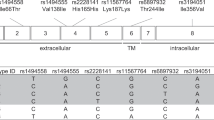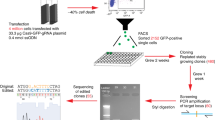Abstract
Alternative splicing of mRNA is an important mechanism for organisms to enhance protein diversity from a limited number of genes. In this report, we described a novel exon insertion in the interleukin 23 (IL-23) receptor between exons 9 and 10, denoted as exon 9a. This 162 base-pair insertion was the only insertion variant discovered in more than 20 IL23R deletion variants found in the mRNA of mitogen-stimulated peripheral blood mononuclear cells (PBMC). Sequence analysis revealed that a pair of GT/AG splice donor–acceptor site and several putative cis-acting sequences were present; the insertion was identified throughout the genome and found to contain homology to the L1 retrotransposon protein. This report describes an insertion in the IL-23 receptor and due to consequent early termination within the intracellular region, causing a possible non-responsive receptor isoform.
This is a preview of subscription content, access via your institution
Access options
Subscribe to this journal
Receive 6 digital issues and online access to articles
$119.00 per year
only $19.83 per issue
Buy this article
- Purchase on Springer Link
- Instant access to full article PDF
Prices may be subject to local taxes which are calculated during checkout


Similar content being viewed by others
Accession codes
References
van de Vosse E, Lichtenauer-Kaligis EG, van Dissel JT, Ottenhoff TH . Genetic variations in the interleukin-12/interleukin-23 receptor (beta1) chain, and implications for IL-12 and IL-23 receptor structure and function. Immunogenetics 2003; 54: 817–829.
Parham C, Chirica M, Timans J, Vaisberg E, Travis M, Cheung J et al. A receptor for the heterodimeric cytokine IL-23 is composed of IL-12R beta 1 and a novel cytokine receptor subunit, IL-23R. J Immunol 2002; 168: 5699–5708.
Beadling C, Slifka MK . Regulation of innate and adaptive immune responses by the related cytokines IL-12, IL-23, and IL-27. Arch Immunol Ther Exp (Warsz) 2006; 54: 15–24.
Oppmann B, Lesley R, Blom B, Timans JC, Xu Y, Hunte B et al. Novel p19 protein engages IL-12p40 to form a cytokine, IL-23, with biological activities similar as well as distinct from IL-12. Immunity 2000; 13: 715–725.
Shimozato O, Ugai S, Chiyo M, Takenobu H, Nagakawa H, Wada A et al. The secreted form of the p40 subunit of interleukin (IL)-12 inhibits IL-23 functions and abrogates IL-23-mediated antitumour effects. Immunology 2006; 117: 22–28.
Annunziato F, Cosmi L, Santarlasci V, Maggi L, Liotta F, Mazzinghi B et al. Phenotypic and functional features of human Th17 cells. J Exp Med 2007; 204: 1849–1861.
Yen D, Cheung J, Scheerens H, Poulet F, McClanahan T, McKenzie B et al. IL-23 is essential for T cell-mediated colitis and promotes inflammation via IL-17 and IL-6. J Clin Invest 2006; 116: 1310–1316.
Wozniak TM, Ryan AA, Britton WJ . Interleukin-23 restores immunity to Mycobacterium tuberculosis infection in IL-12p40-deficient mice and is not required for the development of IL-17-secreting T cell responses. J Immunol 2006; 177: 8684–8692.
Bettelli E, Korn T, Kuchroo VK . Th17: the third member of the effector T cell trilogy. Curr Opin Immunol 2007; 19: 652–657.
Happel KI, Zheng M, Young E, Quinton LJ, Lockhart E, Ramsay AJ et al. Cutting edge: roles of Toll-like receptor 4 and IL-23 in IL-17 expression in response to Klebsiella pneumoniae infection. J Immunol 2003; 170: 4432–4436.
Dong C . Diversification of T-helper-cell lineages: finding the family root of IL-17-producing cells. Nat Rev Immunol 2006; 6: 329–333.
Cho ML, Kang JW, Moon YM, Nam HJ, Jhun JY, Heo SB et al. STAT3 and NF-kappaB signal pathway is required for IL-23-mediated IL-17 production in spontaneous arthritis animal model IL-1 receptor antagonist-deficient mice. J Immunol 2006; 176: 5652–5661.
Aggarwal S, Ghilardi N, Xie MH, de Sauvage FJ, Gurney AL . Interleukin-23 promotes a distinct CD4 T cell activation state characterized by the production of interleukin-17. J Biol Chem 2003; 278: 1910–1914.
Zhang XY, Zhang HJ, Zhang Y, Fu YJ, He J, Zhu LP et al. Identification and expression analysis of alternatively spliced isoforms of human interleukin-23 receptor gene in normal lymphoid cells and selected tumor cells. Immunogenetics 2006; 57: 934–943.
Smith PJ, Zhang C, Wang J, Chew SL, Zhang MQ, Krainer AR . An increased specificity score matrix for the prediction of SF2/ASF-specific exonic splicing enhancers. Hum Mol Genet 2006; 15: 2490–2508.
Black DL . Mechanisms of alternative pre-messenger RNA splicing. Annu Rev Biochem 2003; 72: 291–336.
Ars E, Serra E, de la Luna S, Estivill X, Lazaro C . Cold shock induces the insertion of a cryptic exon in the neurofibromatosis type 1 (NF1) mRNA. Nucleic Acids Res 2000; 28: 1307–1312.
Sridharan V, Singh R . A conditional role of U2AF in splicing of introns with unconventional polypyrimidine tracts. Mol Cell Biol 2007; 27: 7334–7344.
Kwan T, Benovoy D, Dias C, Gurd S, Provencher C, Beaulieu P et al. Genome-wide analysis of transcript isoform variation in humans. Nat Genet 2008; 40: 225–231.
Garcia-Blanco MA, Baraniak AP, Lasda EL . Alternative splicing in disease and therapy. Nat Biotechnol 2004; 22: 535–546.
Graveley BR . The haplo-spliceo-transcriptome: common variations in alternative splicing in the human population. Trends Genet 2008; 24: 5–7.
Jaillon O, Bouhouche K, Gout JF, Aury JM, Noel B, Saudemont B et al. Translational control of intron splicing in eukaryotes. Nature 2008; 451: 359–362.
Kent WJ . BLAT—the BLAST-like alignment tool. Genome Res 2002; 12: 656–664.
Altschul SF, Madden TL, Schaffer AA, Zhang J, Zhang Z, Miller W et al. Gapped BLAST and PSI-BLAST: a new generation of protein database search programs. Nucleic Acids Res 1997; 25: 3389–3402.
Holmes SE, Dombroski BA, Krebs CM, Boehm CD, Kazazian Jr HH . A new retrotransposable human L1 element from the LRE2 locus on chromosome 1q produces a chimaeric insertion. Nat Genet 1994; 7: 143–148.
Prak ET, Kazazian Jr HH . Mobile elements and the human genome. Nat Rev Genet 2000; 1: 134–144.
Wicker T, Sabot F, Hua-Van A, Bennetzen JL, Capy P, Chalhoub B et al. A unified classification system for eukaryotic transposable elements. Nat Rev Genet 2007; 8: 973–982.
Acknowledgements
This work was funded intramurally by HUMIGEN LLC. All authors are employees of HUMIGEN.
Author information
Authors and Affiliations
Corresponding author
Rights and permissions
About this article
Cite this article
Mancini, G., Kan, Sh. & Gallagher, G. A novel insertion variant of the human IL-23 receptor-α chain transcript. Genes Immun 9, 566–569 (2008). https://doi.org/10.1038/gene.2008.51
Received:
Accepted:
Published:
Issue Date:
DOI: https://doi.org/10.1038/gene.2008.51



